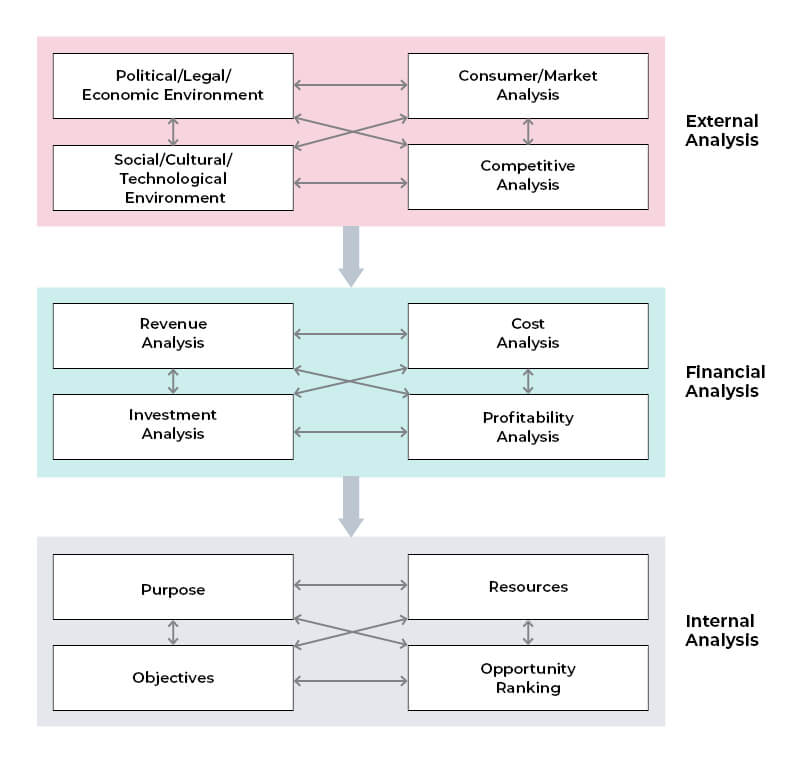Staying competitive and profitable amid rapidly evolving market conditions can be challenging. Emerging technologies, advanced business models, and diminishing product/service life cycles are making it difficult to thrive. Add to it the current global crisis that’s compelling businesses to revisit innovations and strategies previously stalled owing to conventional times.
With the new normal unfolding new consumer demands, agile businesses are eager to turn these disruptions into opportunities to impress customers and bolster their market resilience. That’s where a market opportunity analysis becomes crucial.
What is a market opportunity analysis?
Market opportunity analysis is the process of defining the opportunities available in an organization’s operating environment in terms of external, financial, and internal considerations. It involves evaluating aspects like risks, regulatory environment, potential competitors and customers, and supply chain complexities among others, to ultimately understand the business feasibility of your offering in a specific environment. Here’s a quick snapshot of the steps involved in this study.

A market opportunity analysis is an intricate part of the strategic planning process. The goal of this exercise is to identify new markets where your organization can grow and expand its business. It synthesizes in-depth market research and client data to identify and assess opportunities for business growth across target markets.
For companies eager to ride on the current market scenario, but unsure where to start, here’s how a market opportunity analysis can help uncover strategic insights:
1. Identify market segments that will find your offering relevant
You cannot be everything to everyone. Therefore, identifying customer segments that would want your product/service and are willing to pay is critical to ensure growth beyond the initial launch stage. Segregating your audience based on age, lifestyle, purchase power, product usage, etc., helps you spot and rank segments based on profitability. For B2B audiences, market segments can be bifurcated based on company size, location, revenue, etc.
Doing so offers you clarity on highly relevant market segments, their characteristics, market potential, size, sales potential, and their acquisition and retention costs. The exercise also enables you to uncover segment-based gaps and opportunities within a larger market. Businesses can use this data to inform certain tweaks in their offering to tap into unexplored segments and also develop targeted marketing strategies to fuel better conversions.
2. Recognize unmet consumer needs
Market segmentation makes it easier to identify which customer needs are being addressed and reveal whitespaces that you could strategically leverage. It also helps evaluate potential substitutes or alternatives to your offering in the said market that could act as growth barriers. This enables firms to accordingly plan, design, and deliver their product or service. A market opportunity analysis helps map out such needs and formulate corrective action plans to serve them. Placing your customer at the heart of everything, from product development to promotional strategies can often afford you the first-mover advantage in the market.
For instance, a major infotech solutions provider undertook a market opportunity analysis spanning specific geographies to gain an in-depth view of the indirect taxation software market. This study helped the firm recognize unmet customer needs across various target segments and thereby aided in formulating a unique go-to-market strategy for its indirect taxation software solution across sectors.
Read our case study: Market opportunity analysis of indirect taxation software
3. Find a distinctive advantage and leverage it to diversify
Every organization has its strengths and weaknesses. Benchmarking those of your offerings and processes against that of your competition allows you to find differentiating factors that help you stand out. Here’s where a close eye on your rival’s activities through market intelligence methodologies of competitor tracking, profiling, business model research, competitive benchmarking and SWOT analysis helps. Insights from these initiatives not only reveal your strengths but also allow you to leverage diversification opportunities. These could be product /technology-related, market-related, or non-product/market-related diversification.
A good example of product/technology-related diversification would be a company that manufactures refrigerators using the same cooling technology to develop industrial cold rooms or air conditioners. In terms of market-related diversification, a case in point would be a brand producing nutritional drinks for children, taking a step ahead to offer nutritional recipe books for parents of children within the same market segment. As for non-product/market-related diversification, the dynamics can be starkly different, wherein a firm doesn’t target the same market nor promote the same product, but explores a complementary alternative. For instance, a men’s shoe manufacturer after establishing itself in the market moves into apparel for both men and women.
4. Formulate the right pricing and promotion strategy
Pricing and promotion play a crucial role in achieving the perfect marketing mix for any product or service. A market opportunity analysis provides an in-depth assessment of the reigning prices and consumer expectations across target market segments. These insights combined with prevailing market conditions and regulations help arrive at viable pricing strategies and develop effective promotions.
For instance, the global crisis has compelled different customer segments to react differently in terms of their purchase priorities and where they shop. Some have turned frugal expecting more value for money, while others don’t mind splurging and exploring new products. The pandemic has induced lasting supply chain disruptions, leaving many companies to bear unexpected logistics costs. Factoring in all of these new developments, businesses eager to explore new markets will do well in undertaking a robust opportunity assessment. It will not only help determine ideal price points but also uncover the right promotional channels to fuel recurring sales.
At its core, an opportunity assessment reviews customer purchase journeys to answer the what, when, where, why, and how in terms of pricing, mode of payment, advertising, and promotional strategies that work. It also provides an overview of your direct and indirect competition’s sales and distribution processes including pricing and promotional tactics across platforms offline and online.
5. Identify partnership opportunities for growth and scalability
Expanding your existing market share often requires joining forces with other businesses that complement or add strategic value to your existing capabilities. In some cases, these partners can be critical in gaining market access, given their long-standing repute and industry expertise, or in some cases, it could just be what existing market conditions demand. Through a market opportunity analysis, organizations can evaluate potential partnership opportunities to meet varying business objectives.
From amplifying margins to reducing business risks and future-proofing, among others. Strategic partnerships can help uncover indirect modes to capture market share, access new technologies and IP, acquire new customers, extend product lines, and fuel revenue growth to say the least. A market opportunity analysis offers granular due diligence stakeholders need to make calculative investment and alliance decisions.
For over two decades leading enterprises have sought Netscribes market research solutions to gain in-depth insights on evolving market opportunities. To know how we can help you effectively land and expand on unknown turfs, contact us






